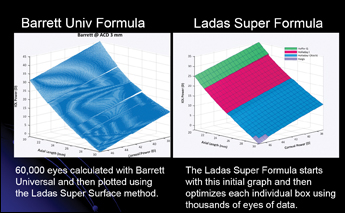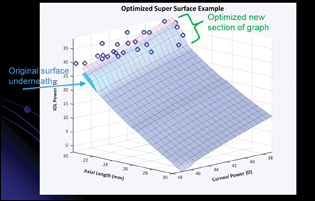Achieving refractive accuracy in cataract surgery
The Ladas Super Formula graphs the sweet spots of all formulae, hones results with big data and incorporates artificial intelligence.

A large meta-analysis of many years’ worth of LASIK studies showed that 99.5% of patients achieved an uncorrected vision of 20/40 or better and 91% of patients achieved 20/20 or better. These 91% of patients were corrected to within ±0.5 D of plano or the intended target. In comparison, cataract surgery is not nearly as good, with only about 60% of patients achieving the same result. Published guidelines for cataract surgeons list 55% as the appropriate target. Surely, we can do better than this.
There have been a lot of improvements in the expensive machines that we use to measure the eye. Going from ultrasound A-scan to optical coherence biometry improved the accuracy of axial length measurement dramatically, by up to 10 times, but that did very little to improve the refractive outcomes in most cases. We are now in the age of microscope-mounted intraoperative aberrometers, and I am in the midst of trying the newest generation of these devices. I must admit, however, that I am disappointed in the initial results, and it strikes me as odd that these devices all request so much input data. If these devices are so accurate, then why do I have to enter any data? Does your autorefractor require you to enter the current prescription before measuring the new one?
The answer is in the mathematics. Our biometry, whether done preop or intraop, is accurate, but the way that we use this data is not as good. In the past we used decision trees to help decide which of the many IOL formulae we should use in a particular case. That was cumbersome and has since transformed into three main approaches: using the sweet spots of multiple formulae (Barrett Universal from Graham Barrett, MD); using an artificial intelligence approach (Hill RBF from Warren Hill, MD); and using a novel way to graph the sweet spots of all formulae, hone the results with big data and incorporate artificial intelligence to constantly improve (Ladas Super Formula from John Ladas, MD, PhD).

Images: Devgan U


Barrett Universal and Hill RBF
Approach one is the Barrett Universal formula, which seems to divide the continuum based on axial lengths as determined by an analysis of 60,000 eyes of data points using this formula and then plotted using the Ladas Super Surface 3-D graphing technique. The details and specifics of the Barrett formula have not been publicly shared to my knowledge. The Barrett Universal is a good choice and certainly better than relying on a single older formula. A published study showed that as is, the Barrett formula can give accuracy of about 80% within ±0.5 D of target.
Approach two is the Hill Radial Basis Function network, which is a type of mathematical modeling that uses a neural network to approximate IOL power based on input parameters, pattern recognition and machine learning. It states that it is specifically intended for a single biometer and a single IOL design and that it may not work the same way with other IOLs or biometers. Artificial intelligence neural networks are used in many other aspects of business, such as handwriting recognition at banks and post offices, where they can function with greater than 99% accuracy. The idea behind “big data” is that machine learning can take place as more and more data are entered. My own personal experience with the Hill RBF is that it works well with the specific IOL for which it is designed.
Ladas Super Formula
Approach three is the Ladas Super Formula, which has evolved into three steps. The first step is using a novel way to visualize IOL calculations by plotting them on a 3-D surface, with IOL power, keratometry and axial length as the three planes. The Ladas Super Formula can also incorporate and graph the measured anterior chamber depth, white-to-white, lens thickness, posterior corneal measurement or any other biometric variable. This allows us to see the data in a new way and to understand that a single formula is not sufficient. A combination of the sweet spots of multiple formulae is used as the original backbone, which looks remarkably similar to the Barrett Universal (Figure 1). With this original graph alone, an accuracy of approximately 80% to 85% of patients within ±0.5 D of target can be achieved. The Ladas Super Formula is appropriate for all models of IOLs and data from all biometers.
Step two for the Ladas Super Formula is to optimize based on actual data. Different from simply modifying an A-constant, each individual box on the graph is optimized so that the entire three-dimensional surface morphs in shape and, therefore, accuracy (Figure 2). The Ladas Super Formula can be optimized for a single surgeon, a group of surgeons or the entire library of data. This is important because for unusual eyes, a single surgeon may not have enough data points (Figure 3). If we are talking about eyes with an axial length longer than 30 mm, each surgeon may only have one or two of these such eyes per year, but when we pool the data from all surgeons, we have hundreds or even thousands of these eyes in the library. Using the optimized Ladas Super Formula, we are able to achieve 86% to 90% accuracy within ±0.5 D of the intended target.
Step three for the Ladas Super Formula is to incorporate an artificial intelligence neural network to further improve accuracy. John Ladas, MD, PhD, is implementing a machine learning model to take accuracy above 90% using thousands (or even millions) of crowd-sourced data points. As more eyes are entered into the database, the algorithm is refined and becomes more accurate. At the time of writing of this article, step one of the Ladas Super Formula is available for free at www.IOLcalc.com, and steps two and three are on the way along with a smartphone app.
The future of IOL calculations is evolving into newer methods with increased accuracy and better visual results for our patients. To determine which method is best for you, feel free to do your own test using patient data from your practice. Get your last couple hundred cataract surgery patients and put the data into the Barrett Universal, Hill RBF and Ladas Super Formula and then see which fares best in your hands. Cataract surgery is our most powerful refractive procedure, and soon it may be the most accurate as well.
- References:
- Cooke DL, et al. J Cataract Refract Surg. 2016;doi:10.1016/j.jcrs.2016.06.029.
- Hill-RBF calculator instructions for use. http://rbfcalculator.com/docs/Hill-RBF-Calculator-Instructions.pdf.
- Sandoval HP, et al. J Cataract Refract Surg. 2016;doi:10.1016/j.jcrs.2016.07.012.
- For more information:
- Uday Devgan, MD, is in private practice at Devgan Eye Surgery, Chief of Ophthalmology at Olive View UCLA Medical Center and Clinical Professor of Ophthalmology at the Jules Stein Eye Institute, UCLA School of Medicine. He can be reached at 11600 Wilshire Blvd. #200, Los Angeles, CA 90025; email: devgan@gmail.com; website: www.DevganEye.com.
Disclosure: Devgan reports he is a principal in Advanced Euclidean Solutions, which owns the Ladas Super Formula, Ladas Super Surface and www.IOLcalc.com.
